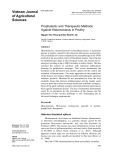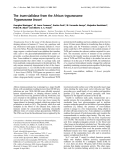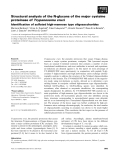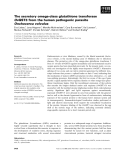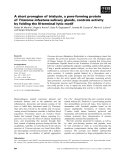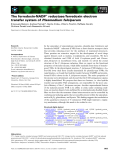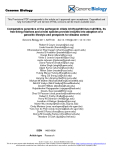
Parasitic diseases
-
Histomoniasis, commonly known as blackhead disease, is a parasitic disease in poultry caused by the protozoan Histomonas meleagridis. The availability of various compounds for chemotherapy in the 1970s resulted in the successful control of blackhead disease.
 13p
13p  vibecca
vibecca
 01-10-2024
01-10-2024
 4
4
 1
1
 Download
Download
-
Để phân định rõ ràng các bệnh của loài cá Salmonid, chúng ta tạm chia các bệnh tật của loài cá Salmonid làm 5 loại khác nhau. - Bệnh do vi khuẩn (Bacterial diseases) - Bệnh do virus (Viral diseases) - Bệnh nấm (Fungal diseases) - Ký sinh Protozoan (Protozoan parasites) - Ký sinh Metazoan (Metazoan parasites) 1/ Bệnh do vi khuẩn (Bacterial diseases): Với cá Salmonids thì các bệnh do vi khuẩn gây nên khá nhiều, một số bệnh thường gặp: Furunculosis: Bệnh gây ra bởi vi khuẩn Aeromonas salmonicida....
 5p
5p  thiepmoi123
thiepmoi123
 24-06-2013
24-06-2013
 79
79
 4
4
 Download
Download
-
Trypanosoma brucei is the cause of the diseases known as sleeping sickness in humans (T. brucei ssp. gambiense and ssp. rhodesiense) and ngana in domestic animals (T. brucei brucei) in Africa. Procyclic trypomastigotes, the tsetse vector stage, express a surface-bound trans-sialidase that transfers sialic acid to the glycosylphosphatidylinositol anchor of procyclin, a surface glycoprotein covering the parasite surface. Trans-sialidase is a unique enzyme expressed by a few trypanosomatids that allows them to scavenge sialic acid from sialylated compounds present in the infected host. ...
 10p
10p  system191
system191
 01-06-2013
01-06-2013
 44
44
 4
4
 Download
Download
-
Trypanosoma cruzi, the parasitic protozoan that causes Chagas disease, contains a major cysteine proteinase, cruzipain. This lysosomal enzyme bears an unusual C-terminal extension that contains a number of post-translational modifications, and most antibodies in natural and experimen-tal infections are directed against it. In this report we took advantage of UV-MALDI-TOF mass spectrometry in conjunction with peptide N-gly-cosidase F deglycosylation and high performance anion exchange chroma-tography analysis to address the structure of the N-linked oligosaccharides present in this domain. ...
 13p
13p  fptmusic
fptmusic
 11-04-2013
11-04-2013
 42
42
 2
2
 Download
Download
-
Glucose-6-phosphate isomerase catalyzes the reversible aldose-ketose isomerization of D-glucose-6-phosphate to D-fructose-6-phosphate in glycolysis and gluconeogenesis, and in the recycling of hexose-6-phosphate in the pentose phosphate pathway. The unicellular protozoans,Trypan-osoma brucei, T. cruziandLeishmaniaspp., of the order Kinetoplastida are important human parasites responsible for African sleeping sickness, Chagas’ disease and leish-maniases, respectively. In these parasites, glycolysis is an important (and in some cases the only) metabolic pathway for ATP supply....
 8p
8p  dell39
dell39
 03-04-2013
03-04-2013
 35
35
 3
3
 Download
Download
-
Onchocerciasis or river blindness, caused by the filarial nematodeOncho-cerca volvulus, is the second leading cause of blindness due to infectious diseases. The protective role of the omega-class glutathione transferase 3 from O. volvulus(OvGST3) against intracellular and environmental reactive oxygen species has been described previously.
 16p
16p  galaxyss3
galaxyss3
 07-03-2013
07-03-2013
 44
44
 2
2
 Download
Download
-
Triatoma infestans(Hemiptera: Reduviidae) is a hematophagous insect that transmits the protozoan parasite Trypanosoma cruzi, the etiological agent of Chagas’ disease. Its saliva contains trialysin, a protein that forms pores in membranes. Peptides based on the N-terminus of trialysin lyse cells and fold into a-helical amphipathic segments resembling antimicrobial peptides. Using a specific antiserum against trialysin, we show here that trialysin is synthesized as a precursor that is less active than the protein released after saliva secretion. ...
 9p
9p  media19
media19
 06-03-2013
06-03-2013
 47
47
 2
2
 Download
Download
-
In the apicoplast of apicomplexan parasites, plastidic-type ferredoxin and ferredoxin-NADP + reductase (FNR) form a short electron transport chain that provides reducing power for the synthesis of isoprenoid precursors. These proteins are attractive targets for the development of novel drugs against diseases such as malaria, toxoplasmosis, and coccidiosis.
 12p
12p  vinaphone15
vinaphone15
 25-02-2013
25-02-2013
 30
30
 2
2
 Download
Download
-
Tuyển tập các báo cáo nghiên cứu về y học được đăng trên tạp chí y học Wertheim cung cấp cho các bạn kiến thức về ngành y đề tài: Comparative genomics of the pathogenic ciliate Ichthyophthirius multifiliis, its free-living relatives and a host species provide insights into adoption of a parasitic lifestyle and prospects for disease control...
 82p
82p  thulanh22
thulanh22
 20-11-2011
20-11-2011
 96
96
 6
6
 Download
Download
-
Malaria, caused by four species of Plasmodium, of which Plasmodium falciparum is the most dangerous, remains the world's most devastating human parasitic infection. This chapter deals with the properties and uses of important drugs used to treat and prevent this infection. Highly effective agents that act against asexual erythrocytic stages of malarial parasites responsible for clinical attacks include chloroquine, quinine, quinidine, mefloquine, atovaquone, and the artemisinin compounds.
 362p
362p  vanass
vanass
 01-04-2011
01-04-2011
 80
80
 8
8
 Download
Download
-
Brain Masses Mass lesions of the brain most often present as headache with or without fever or neurologic abnormalities. Infections associated with mass lesions may be caused by bacteria (particularly Nocardia), fungi (particularly Cryptococcus or Aspergillus), or parasites (Toxoplasma). Epstein-Barr virus (EBV)–associated lymphoproliferative disease may also present as single or multiple mass lesions of the brain. A biopsy may be required for a definitive diagnosis. Pulmonary Infections Pneumonia (Chap.
 5p
5p  konheokonmummim
konheokonmummim
 03-12-2010
03-12-2010
 76
76
 4
4
 Download
Download
-
Eosinophilia Eosinophilia is the presence of 500 eosinophils per µL of blood and is common in many settings besides parasite infection. Significant tissue eosinophilia can occur without an elevated blood count. A common cause of eosinophilia is allergic reaction to drugs (iodides, aspirin, sulfonamides, nitrofurantoin, penicillins, and cephalosporins). Allergies such as hay fever, asthma, eczema, serum sickness, allergic vasculitis, and pemphigus are associated with eosinophilia. Eosinophilia also occurs in collagen vascular diseases (e.g.
 5p
5p  konheokonmummim
konheokonmummim
 03-12-2010
03-12-2010
 81
81
 5
5
 Download
Download
-
Endophthalmitis This occurs from bacterial, viral, fungal, or parasitic infection of the internal structures of the eye. It is usually acquired by hematogenous seeding from a remote site. Chronically ill, diabetic, or immunosuppressed patients, especially those with a history of indwelling IV catheters or positive blood cultures, are at greatest risk for endogenous endophthalmitis. Although most patients have ocular pain and injection, visual loss is sometimes the only symptom.
 5p
5p  ongxaemnumber1
ongxaemnumber1
 29-11-2010
29-11-2010
 95
95
 6
6
 Download
Download
-
Use of Fungi for Insect Control - Issues, Developments & Research Needs Entomopathogenic Fungi • Classification • Pathogenesis • Why fungi as BCA’s? • Commercialization • Registration • Some examples • Research Agriculture and Agriculture et Agri-Food Canada Agroalimentaire Canada
 67p
67p  dalatngaymua
dalatngaymua
 29-09-2010
29-09-2010
 100
100
 28
28
 Download
Download
-
1. Tên học phần: - BỆNH KÝ SINH TRÙNG Ở ĐỘNG VẬT THỦY SẢN - FISH PARASITIC DISEASES 2. Số đơn vị học trình: - Lý thuyết: 3 đvht - Thực hành: 1 đvht 3. Trình độ: Sinh viên năm thứ 3 bậc đại học, ngành bệnh học thủy sản.
 5p
5p  nguyentainang1610
nguyentainang1610
 15-03-2010
15-03-2010
 263
263
 49
49
 Download
Download
CHỦ ĐỀ BẠN MUỐN TÌM








